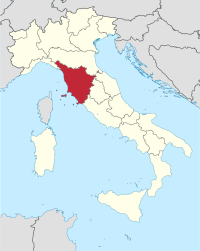
Photo from wikipedia
Scholars such as Benedict Anderson, Eric Hobsbawm, and Hugh Seton-Watson have examined how nation and nationhood are significantly intertwined with language, a relationship which has been prominent in the scholarship… Click to show full abstract
Scholars such as Benedict Anderson, Eric Hobsbawm, and Hugh Seton-Watson have examined how nation and nationhood are significantly intertwined with language, a relationship which has been prominent in the scholarship on the construction of nationhood and national communities for the last thirty years. The significance of Italian dialects to Italian national identity has been examined by historians such as Porciani (1997; 2012), Foot (2003), Brucker (2005), and Patriarca (2010), who analyze the importance of local and regional identities in Italian nationbuilding since the Middle Ages. Nationhood and language were co-constitutive in latenineteenth-century Italian society: the Italian governments made substantial efforts to institute a united, homogeneous, and unilingual community after unification, and to situate language within a discourse of national character. Regional identities also impacted on Italian national communities. This article focuses on how the schoolbooks of Carlo Lorenzini, widely known as Collodi (1826–1890), responded to the promotion, by the post-unification Italian governments, of a standardized national Italian language to a heterogeneous population accustomed to communicating using various dialects, which were thought of as being an inferior mode of expression by nationalist ideologues. Beyond Le avventure di Pinocchio, the first episode of which was published in 1883 in the magazine Il giornale per i bambini, Collodi wrote many schoolbooks, mostly centered around the young middleclass child Giannettino and his path towards a conservative education led by his mentor Dottor Boccadoro. The first text, Giannettino, published in 1877, was named after Parravicini’s Giannetto, the most popular schoolbook at the time. Giannettino was followed by La grammatica di Giannettino (1883), L’abbaco di Giannettino (1885), La geografia di Giannettino (1886b), and Il viaggio per l’Italia di Giannettino (1880, 1883, 1886a), a volume made up of three books dedicated to tales of Giannettino’s travels throughout Italy’s north, center, and south. La lanterna magica di Giannettino, in 1890, concluded the collection. I examine Collodi’s approach to language and implied stance on local dialects in his schoolbooks, and how they contributed to a discourse of Italian national character. I argue that Collodi represents local dialects as being an important part of the cultural heritage of local communities, and one that ought to be preserved and respected. Thus, this
Journal Title: Nineteenth-Century Contexts
Year Published: 2023
Link to full text (if available)
Share on Social Media: Sign Up to like & get
recommendations!